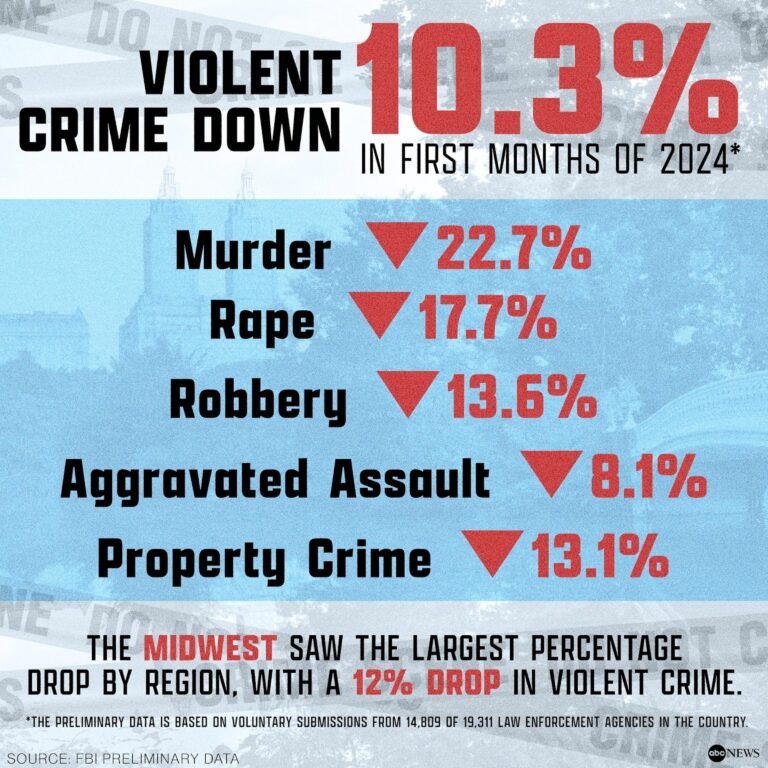Decoding Violent Crime Trends: Stability Amidst Public Concern
Current Landscape of Violent Crime: A Balanced Perspective
Recent discussions about violent crime rates have been polarized, with some commentators warning of alarming increases, while others argue that crime is on the decline. However, a detailed review of the most recent statistics reveals a more balanced picture. According to a comprehensive analysis published by The Washington Post, violent crime rates have neither surged uncontrollably nor dropped significantly but have instead remained relatively steady over recent years. This understanding is vital for policymakers and communities aiming to address safety concerns with clarity and precision in an evolving social environment.
Examining the Data: Trends in Violent Crime Across the Nation
Data collected from various metropolitan areas across the United States illustrate a complex and nuanced pattern in violent crime rates. While there are annual variations, these shifts generally oscillate around a consistent baseline, indicating no dramatic upward or downward trend. Experts attribute this stability to a combination of factors including evolving law enforcement tactics, community engagement initiatives, and economic conditions. Notably, increases in violent incidents in certain localities are often counterbalanced by reductions in others, maintaining an overall national equilibrium.
Key observations from recent crime statistics include:
- Homicide rates: Minor regional differences exist, but the national average remains largely unchanged.
- Aggravated assaults: These have seen slight fluctuations, influenced by demographic shifts and economic factors.
- Robbery occurrences: Urban centers report modest declines, whereas some smaller towns experience slight increases.
| Crime Category | 2022 Rate (per 100,000) | 2023 Rate (per 100,000) | Percentage Change |
|---|---|---|---|
| Homicide | 5.1 | 5.3 | +3.9% |
| Aggravated Assault | 250.4 | 248.7 | -0.7% |
| Robbery | 102.2 | 99.3 | -2.8% |
These statistics highlight the importance of looking beyond sensationalized reports to appreciate the steady nature of violent crime trends. While isolated violent events may capture headlines and public attention, the broader data indicate a relatively stable crime environment.
Key Drivers Sustaining Violent Crime Rates
Despite widespread perceptions of escalating violence, several underlying factors contribute to the persistence of violent crime rates. Economic conditions, such as unemployment and income disparity, remain significant influences on criminal activity. Additionally, community dynamics—including policing approaches and social cohesion—play a crucial role in shaping crime patterns. Researchers emphasize that violent crime is deeply intertwined with broader societal contexts rather than existing in isolation.
Additional factors impacting violent crime include:
- Population demographics: Variations in the proportion of young adults affect crime rates, as this age group is statistically more involved in violent offenses.
- Firearm accessibility: The availability of guns can intensify conflicts and increase the likelihood of violent outcomes.
- Community values and norms: Local attitudes toward violence and law enforcement influence crime prevalence.
- Criminal justice policies: Sentencing guidelines and rehabilitation efforts shape long-term crime trends.
| Influencing Factor | Impact on Violent Crime |
|---|---|
| Unemployment | Higher unemployment correlates with increased violent crime |
| Gun Access | Elevates both frequency and severity of violent incidents |
| Community Policing | Reduces violent crime through improved relations |
| Youth Demographics | Greater youth population often leads to higher crime rates |
Media Influence: Shaping Public Views on Crime Trends
The portrayal of crime in the media significantly affects public perception, often amplifying fears or downplaying risks irrespective of actual data. Sensational headlines and selective coverage tend to emphasize violent crimes, sometimes creating a distorted image of rampant violence even when statistics show stability or minor fluctuations. This skewed narrative can influence public opinion and policy decisions by focusing on extreme incidents rather than comprehensive trends.
Factors contributing to media-driven perceptions include:
- Prioritizing violent crime stories over property or financial crimes.
- Highlighting short-term spikes instead of long-term data.
- Using emotionally charged language to attract readership.
- Repetitive coverage of dramatic events fostering a sense of crisis.
To better understand this dynamic, consider the following comparison between media emphasis and actual crime data:
| Aspect | Media Portrayal | Statistical Reality |
|---|---|---|
| Violent Crime | Frequently described as “exploding” or “skyrocketing” | Generally stable with minor year-to-year changes |
| Property Crime | Less prominently covered, perceived as less urgent | Gradual and consistent decline over time |
| Crime Trends | Focus on immediate spikes and sensational cases | Long-term data shows a plateau or slight decrease |
Strategic Approaches to Managing Violent Crime Responsibly
Addressing violent crime effectively demands a measured approach that balances acknowledging community concerns with avoiding alarmist rhetoric. Policymakers should prioritize strengthening community policing initiatives that foster trust and collaboration between law enforcement and residents. Additionally, investing in social programs—such as mental health services, educational opportunities, and youth engagement—can address underlying causes of violence. Employing data-driven strategies allows for targeted interventions, optimizing resource allocation and minimizing unnecessary broad measures.
Successful crime reduction efforts require cooperation among diverse stakeholders, including:
- Nonprofit organizations working to alleviate poverty and social disparities.
- Educational institutions implementing conflict resolution and mentorship programs.
- Law enforcement agencies emphasizing transparency and community accountability.
- Public health professionals focusing on substance abuse prevention and treatment.
| Policy Focus | Core Initiative | Anticipated Benefit |
|---|---|---|
| Community Policing | Enhanced patrols combined with community engagement | Improved trust and quicker crime reporting |
| Education | Conflict resolution curriculum in schools | Reduction in youth-related violence |
| Social Services | Expanded access to mental health and job training | Lower recidivism and reduced crime drivers |
Final Thoughts: Navigating the Complex Reality of Violent Crime
In conclusion, fears of a dramatic upswing in violent crime are not substantiated by current data, nor is there clear evidence of a sustained decline. The reality is multifaceted, underscoring the importance of informed dialogue and evidence-based policy responses. As communities and law enforcement agencies continue to confront the challenges posed by crime, ongoing analysis, transparent communication, and collaborative efforts will be essential to understanding trends and crafting effective solutions.







